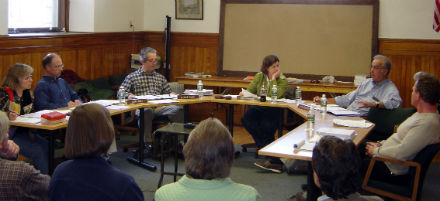
Statewide efforts to improve the water quality in Lake Champlain and other Vermont lakes, rivers, and streams have drawn a lot of attention. The health of Vermont's water bodies is clearly linked to surrounding land use and development. Stormwater runoff and soil erosion are primary sources of phosphorus, the major nutrient pollutant in Lake Champlain. With residential and other land development increasing throughout the state, there is an urgent need to ensure that this development occurs with minimal impact on water quality.
Vermont municipalities are uniquely positioned to implement local standards and strategies to protect and improve water quality and water resources. Good water quality protection goals in town plans provide the legal support for local zoning standards and ordinances, and promote projects that improve and enhance water resources. Municipal programs and regulations provide an important component of phosphorus control, as state regulations do not have jurisdiction over most small scale and incremental development.
Many of Vermont's 255 municipalities do not have adequate standards in their zoning bylaws or other applicable ordinances to address stormwater runoff and soil erosion or to protect river corridors and floodplains. With support from the Vermont Agency of Natural Resources, a Water Resource Coordinator, housed at the Vermont League of Cities and Towns' (VLCT) Municipal Assistance Center provides free technical assistance and training for municipalities seeking to take greater steps to protect water quality and water resources. Milly Archer, the Water Resources Coordinator, assists planning commissions and other local boards that are considering changes to local zoning bylaws and provides model and sample regulatory language, fact sheets, and other tools for water quality and water resource protection. Work focuses on stormwater management, municipal implementation of the Lake Champlain Total Maximum Daily Load, green stormwater infrastructure, river corridor protection, and flood hazard protection. For more information, contact her at marcher@vlct.org.
What is your town doing to improve water quality and reduce phosphorus loading? Measures that can be implemented at the town level to provide phosphorus control include:
- Low Impact Development (LID) and Green Stormwater Infrastructure (GSI). LID and GSI stormwater management standards incorporate best management practices that avoid and minimize land disturbance and impervious surfaces, protect natural topography, and reduce the volume and water quality impacts of stormwater runoff. State stormwater regulations do not cover all potential development. By adopting local stormwater standards that incorporate LID and GSI, municipalities can take the upper hand in protecting downstream stormwater infrastructure, local water quality, and properties adjacent to development sites.
- River Corridor and Floodplain Protection. Functioning river corridors and floodplains can achieve reduced flood and erosion hazards as well as important water quality benefits. Restricting development within a river corridor and floodplain will prevent development in high flood risk areas which will protect public safety, reduce flood damages to public infrastructure and private property, reduce the taxpayer-funded flood recovery costs, and improve water quality.
- Construction erosion control standards. Soil disturbed or exposed during construction is ripe for erosion when it rains. Development projects that disturb less than one acre of land are not required to obtain a State of Vermont construction erosion control permit. The cumulative adverse effects on water quality from the so-called "sub-jurisdictional" projects that fall below the State permitting thresholds can be quite significant. Municipalities can reduce the water quality impacts of erosion by adopting construction standards that apply to proposed development on sites of less than one acre.
- Vegetated riparian buffers. A vegetated buffer between development and water filters sediment from runoff, removes phosphorus through infiltration into the soil, and protects steep slopes and erosion-prone areas. By incorporating riparian buffer standards applicable to small streams and river corridors, municipalities can protect water quality by trapping and removing sediment from stormwater runoff.
- Subdivision Standards. Municipalities can adopt subdivision standards that reduce impervious areas and incorporate environmentally sensitive and efficient uses of the land through the regulation of new parcel layout and site design.
There are also many non-regulatory phosphorus control options for towns, including outreach to landowners and contractors, land trusts and conservation easements, and re-planting riparian buffers on stream banks and lake shorelands. VLCT offers an archive of related resources.
Vermont Association of Planning and Development Agencies
VAPDA is devoted to sound planning principles that will enhance the quality of life for Vermont residents. Through a combination of environmental and economic planning strategies, VAPDA fosters a community environment that provides for the needs of both residents and our natural surroundings, today and for generations to come.
